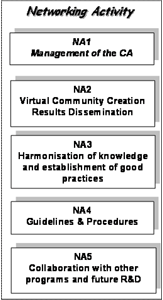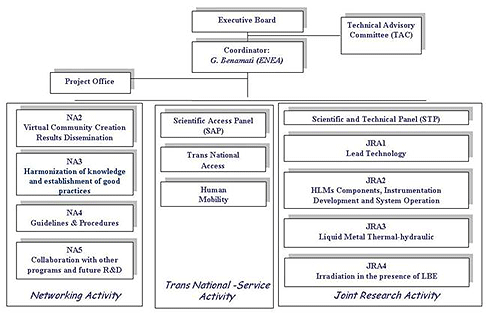OVERVIEW

The Networking Activities (NA) are five activities which have as principal
objective the creation of a virtual community of researchers, the definition
of common standards and protocols for the use of the facilities and the
interaction with the other programmes and institutions operating in this
field.
NETWORKING ACTIVITY 1:
“MANAGEMENT OF THE CONSORTIUM ACTIVITIES”
Responsible person: Mariano Tarantino, ENEA - mariano.tarantino@enea.it
The management of VELLA entails mainly the co-ordination of all the technical activities of the I3, the legal, contractual, financial and administrative management, the maintenance of the contacts with the Commission, the steering and monitoring of the time schedule, the budget, the deliverables and the milestones, the preparation of meetings and the implementation of dissemination measures, the co-ordination of the knowledge management, the realization of the required documentation, the dissemination and publishing of the results.
In this framework, in order to perform the abovementioned activities, a management structure articulated as following has been set up:
- The Executive Board (EB) is the Consortium decision-making and arbitration body.
- The Technical Advisor Committee (TAC) is the body responsible for scientific advices and recommendations covering the topics of the Project.
- The Scientific Access Panel (SAP) is the body responsible for the selection of the accesses to the infrastructures during the whole duration of the Project, the selection of the Human Mobility (HM) applications, the monitoring of the accepted actions.
- The Scientific and Technical Panel (STP) is the body managing the Joint Research Activities within the project execution.
- The Co-ordinator is the single point of contact between the EC and the Consortium and it is responsible for the project management.
- The Project Office (PO) is the body which manage the administrative, legal, financial and other non-technical aspects of the Project and assist the abovementioned bodies and the Coordinator in their activities.

NETWORKING ACTIVITY 2:
“VIRTUAL COMMUNITY CREATION AND RESULTS DISSEMINATION”
Responsible person: Mariano Tarantino, ENEA - mariano.tarantino@enea.it
One of the key objectives of VELLA is the creation of a real community, although in a virtual form, of researchers in the field of HLM technologies for nuclear applications.
This goal can be achieved thanks to the development of protocols for the exchange of information and the editing of the technical documents common to all the project structures. These protocols have to facilitate the access to the knowledge, to the publications and to the obtained results; moreover, they should improve the exchange of opinions and experience among the researchers.
Another important issue of this Networking Activity is the organization of dedicated workshops on specific issues related to the HLM technologies.
The activities envisaged in this NA should survive well beyond the end of the project. One of the main objectives of the VELLA consortium, in fact, is to create a long-term structure, a common platform of work which will continue also after the end of the project. As a matter of fact, if each partner could access the web site and upgrade it, even after the end of the initiative.
the web site would work as a focused information point about the HLM technologies.
NA2 INVOLVED INSTITUTIONS :: CNRS - ENEA - FZK - SCK•CEN
NETWORKING ACTIVITY 3:
“HARMONIZATION OF KNOWLEDGE AND ESTABLISHMENT OF GOOD PRACTICES”
Responsible person: Dominique Gorse, CNRS - Dominique.Gorse@glvt-cnrs.fr
The objective of this activity is twofold:
- improvement and harmonization of the scientific knowledge of the present generation of scientists and engineers coming from different areas of the nuclear R&D projects of the VIth FP related to HLM(s)
- preparation of the new generation of scientists by giving them a common platform of knowledge and developing their skills in all aspects of HLM technologies and related areas. The aim is an increasing efficiency for the GIF reactor concepts, going from the production of energy in LMFBRs to the incineration of nuclear wastes by transmutation in ADS.
- Thematic workshops will be organized by the VELLA partners during the I3 duration. The central theme is HLM technology, as a spallation material and coolant of the ADS and the Generation IV reactor concepts.
- Good practices’ workshops will be organized for young researchers involved in the field of Nuclear science coming from Universities, Agencies or Companies in the different research teams or laboratories of the Organizations grouped in VELLA.
The expected impact of this NA will primarily be the diffusion of knowledge on HLMs among the European Scientific Community working on the GIF reactor concepts, followed by the development of a close cooperation between nuclear scientists from different backgrounds in the EU. Moreover, the activities will favour interactions between metallurgists, nuclear scientists and designers, and will promote close collaboration between R&D at the industrial level and more academic research, and will contribute to fill the gap between partners who should build and operate safe and reliable reactors in the 21st century. This NA3 activity will benefit from the actions carried out in MATLAB, and CHEMLAB and should also benefit from the RAs proposed in VELLA.
NA3 INVOLVED INSTITUTIONS :: CNRS - ENEA - FZK - SCK•CEN - FZD - KTH - NRI - IPUL - CEA
NETWORKING ACTIVITY 4: “GUIDELINES AND PROCEDURES”
Responsible person: Dolores Gomez Briceno, CIEMAT - lola.gomezbriceno@ciemat.es
The main objective of the NA4 is the development of guidelines for relevant issues for future HLM systems:
materials, corrosion tests, determination of mechanical properties, calibration of oxygen sensors and measurements of oxygen concentration.
To reach this objective a critical review of the available information on the mentioned topics will be carried out, analysing the experimental procedures used in the different labs in order to assess the quality of the data. The identification of some parameters/conditions not well covered by the available information and the necessity of carrying out specific experiments to remedy it is foreseen. If needed, these experiments will be performed as a part of JRA 1.
The expected impact of this networking activity will be to provide the research community with recommendations and procedures to perform material studies and oxygen control measurements and the engineers with reliable data to be used for the design and construction of new HLM systems. This networking activity represents the needed forum for discussion andunderstanding on topics relevant for the future of this type of systems.It is foreseen that the recommendations and procedures issued, as results of this activity, will be used by the labs involved in HLM investigations. If possible, standard proposal will be written to be submitted to ISO.
NA4 INVOLVED INSTITUTIONS :: CIEMAT - ENEA - CEA - CNRS - FZK - IQS - NRI - SCK•CEN - IPUL - CNR - PSI
NETWORKING ACTIVITY 5:
“COLLABORATIONS WITH OTHER PROGRAMMES AND FUTURE R&D”
Responsible person: Mariano Tarantino, ENEA - mariano.tarantino@enea.it
A large effort is in progress worldwide on HLM technology especially in the fields of ADS, GEN IV and Fusion Blanket systems. In addition to the European project EUROTRANS-DEMETRA and the new ELSY proposal, significant R&D actions are on going in USA and in Russia. Indeed several important international Institutions (i.e. OECD, ISTC) are promoting, and/or financing, activities in the field of HLM.
The main objective of this NA are twofold. The first one is to promote a real integration among the EU activities on HLM already going on within Europe in several fields: Transmutation, GEN IV and Fusion.
The second one is to establish regular and coherent links among National, European and International programmes in the field of HLM technological development in order to increase the possible technical cooperation in such a way so as to maximise the profit of the ongoing activities. Efforts will be made to cooperate with similar non-European infrastructures such as PROMETEY, St. Petersburg, IPPE, Obninsk, DELTA loop, the USA and others in Japan and the Republic of Korea, to share the latest information on an equal footing and seeking convergence in technology assessment. Another objective of this NA is to have at the end of the VELLA programme a general survey of the status of HLM technologies development in EU, and in the rest of the world, reporting the major results achieved, the open point and the needs of future research
NA4 INVOLVED INSTITUTIONS :: ENEA - CEA - CIEMAT - CNRS - FZK - SCK•CEN
